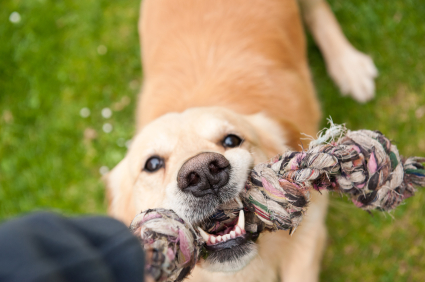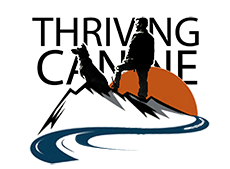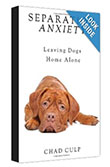 The conflicting opinions on this are right up there with leash corrections and prong collars. It often falls into the “I heard you weren’t suppose to” category while on the other hand, there are trainers that use it as a large part of their program. In my view, dog training is never one-size-fits-all…it should be customized to every dog. That being said, we have two major things to take into consideration when determining if Tug is a game you should play with your dog. Number one… is your dog’s temperament an appropriate fit for this game that is aggressive by nature. Number two… how comfortable are you, the handler, with the responsibility of managing this game properly.
The conflicting opinions on this are right up there with leash corrections and prong collars. It often falls into the “I heard you weren’t suppose to” category while on the other hand, there are trainers that use it as a large part of their program. In my view, dog training is never one-size-fits-all…it should be customized to every dog. That being said, we have two major things to take into consideration when determining if Tug is a game you should play with your dog. Number one… is your dog’s temperament an appropriate fit for this game that is aggressive by nature. Number two… how comfortable are you, the handler, with the responsibility of managing this game properly.
Tug: An Organized Sport
Tug should be treated like an organized sport where you are the coach. Like organized sports, Tug-of-War should have rules that you control at all times. You control when the game begins, when it ends, how exciting it gets and who wins. If the game is played correctly there are a lot of benefits to be gained. On the other hand, if it is played as unstructured willie-nilly rough housing (especially with a dog whose temperament may not be a good fit for Tug) some very valid concerns can become realities. That is why Tug is such a controversial game. So to be a responsible Tug coach, first you’ll need to look at your dog’s temperament to see if they are a good fit for a game like Tug. If you need help evaluating your dog, call in a professional.
Your dog’s temperaments can range from shy and fearful to dominant and aggressive. If you have a timid dog, Tug can be a great way to build their confidence. If your dog is dominant or aggressive, there are a couple of things you’ll need to consider. Done improperly, you can increase your dog’s aggressive tendencies. Because Tug is an aggressive game, if you have an aggressive dog, you should be honest with yourself as to whether Tug is a good game for you to play. If the answer is yes, you need to understand that you are committing to being a firm coach while really understanding how to control the game. And, be honest with yourself. If it’s not working, be prepared to abandon Tug altogether. For most of the dogs between these two extremes, Tug can be a fun game providing a lot of benefits, assuming the game is managed properly.
Benefits:
Physical and mental exercise for your dog: Exerts physical energy while they mentally focus on the rules and changes in the game
Strengthens your leadership position: You are the coach controlling all elements of the game
Safe outlet for your dog to demonstrate natural predatory instincts
Builds your dog’s confidence: Be sure to let them win occasionally to assist this properly
Exercise to help strengthen ‘Drop’ command: Transfers to real life situations as dogs learn to surrender what’s in their mouth when asked to
Manages impulse control: Looking to you for direction
Helps eliminate “possession aggression”: Helps dogs become comfortable with having your hands around their face and mouth
Few More Things:
Be sure to pull towards you, don't yank.
During a good game of Tug, don’t be surprised if your mild-mannered dog begins to growl and pull. That’s the idea and it is healthy. Just be sure to manage it to make sure it doesn’t get out of hand. If your dog gets out of hand. Stop the game and have them drop the toy. Remember, you call the shots.
Protect your dog’s teeth and neck muscles. Start out gently (regardless of your dog’s age) and play for short periods of time. Be extra cautious when they are young and teething (generally 4-6 months old). Pull the toy toward you or up and down, not side to side and don't yank. That way, the dogs aren’t caught off guard.
If your dog yanks or pulls side to side, it's o.k because their muscles are prepared for it.
Tug is a rewarding game and can be an effective training tool. Some dogs are treat or ball motivated and some are Tug motivated. Use this to your advantage in advanced training.
As dogs begin to understand the rules of the game and you become a master at controlling the game, you can increase the intensity and the play time.
Follow up with a Professional:
Since we are only examining the benefits of Tug-of-War while addressing common concerns of the game, I recommend you follow up with a professional if you have any questions on the “how-tos” of playing the game properly.
Good times to be had by all…
So in summary, you can see I’m an advocate of playing Tug-of-War with your dog(s) taking into account all I’ve mentioned in this article. You will become a more confident and respected handler, your dogs will become more fulfilled and challenged and good times will be had by all. Have fun, be safe and enjoy!
Chad Culp–Certified Dog Trainer, Behavior Consultant, Certified Holistic Chef for Animals
Copyright 2005-2013 Chad Culp, Thriving Canine. All rights reserved. Chad@ThrivingCanine.com
Check out www.ThrivingCanine.com for more free articles, videos and sign up for the weekly newsletter.
Subscribe to Thriving Canine YouTube Channel
Apply for membership of the THRIVING CANINE UNIVERSITY Facebook group. (please read the rules before joining)



